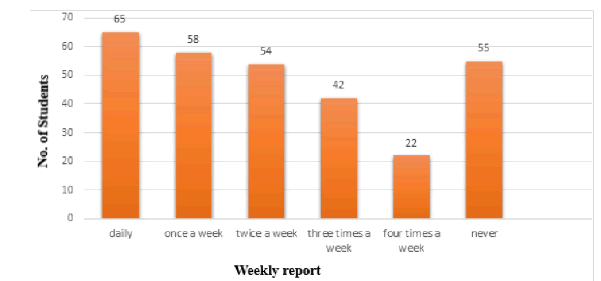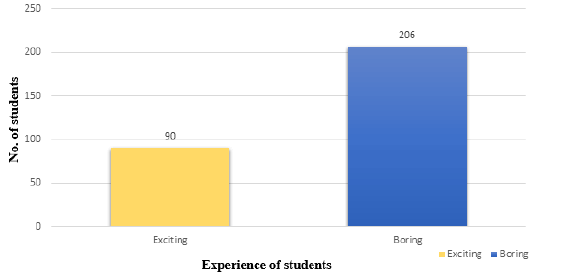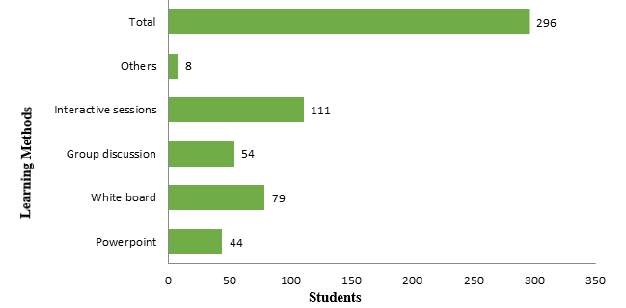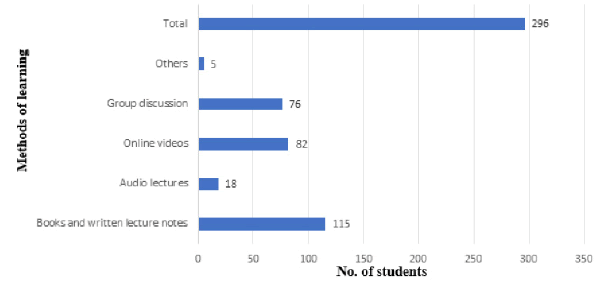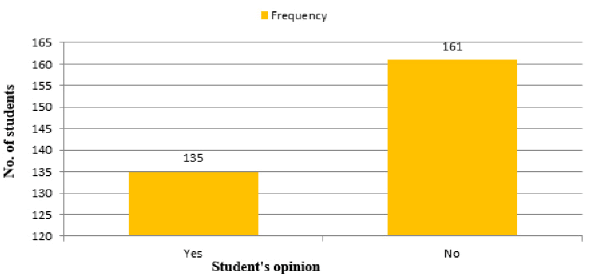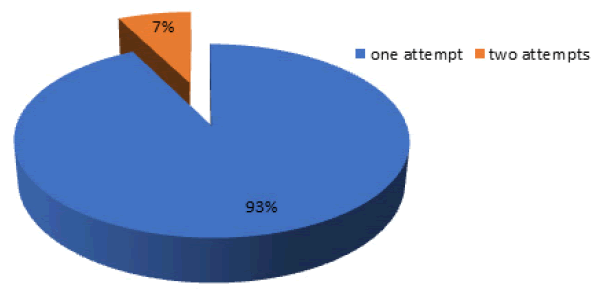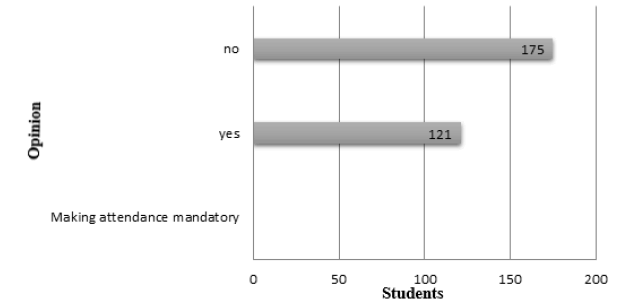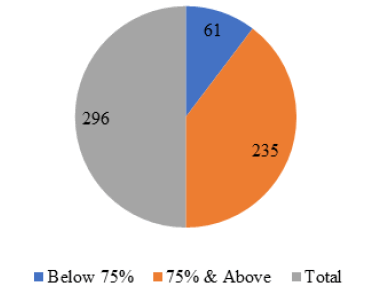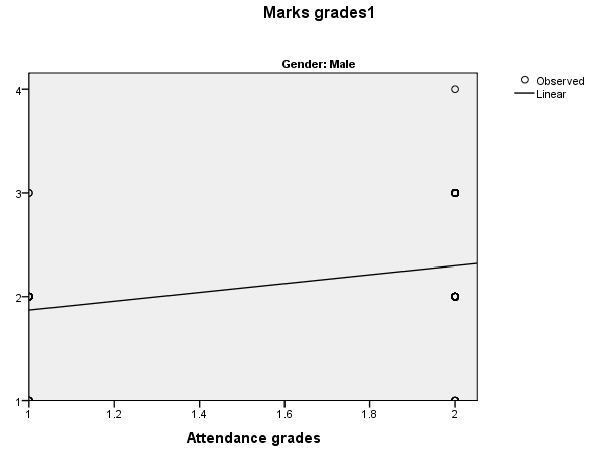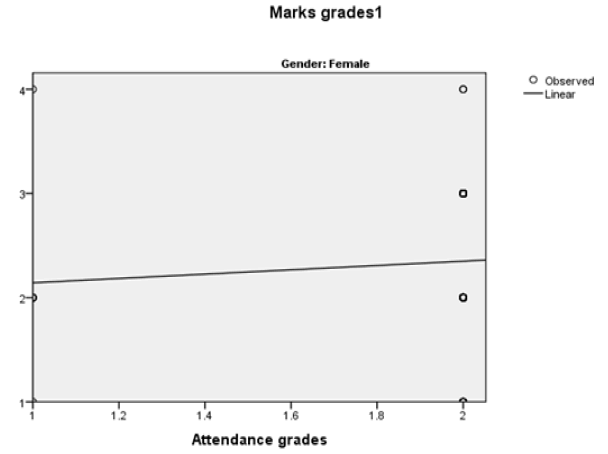Research Article - Clinical Investigation (2022) Volume 12, Issue 6
Correlation of attendance with grades in students of ayub medical college abbottabad, Pakistan
- Corresponding Author:
- Khalid Shahzad
Resident General Medicine, Pakistan Atomic Energy Commission General Hospital, Islamabad, Pakistan
E-mail: khalidshahzad996@gmail.com
Received: 15-June-2022, Manuscript No. FMCI-22-66665; Editor assigned: 16- June-2022, PreQC No. FMCI-22-66665 (PQ); Reviewed: 17-June-2022, QC No. FMCIFMCI- 22-66665 (Q); Revised: 22-June-2022, Manuscript No. FMCI-22-66665 (R); Published: 10- July-2022, DOI: 10.37532/2041-6792.2022.12(6).135-145
Abstract
Background: A student’s commitment to medical education is evaluated by their interest shown in attending classes. Medical education demands high attendance for good command and understanding over the subject, and a better understanding of a subject in the field of medicine provides a basis for professionalism, this sets attendance and performance in a position to be investigated if they are correlated, In this study we opted to test this correlation in undergraduate medical students.
Objectives: To find out if there is any correlation (positive, negative or none) between a student’s attendance in class and annual examination performance.
Methods: This cross-sectional study was performed in Ayub medical college on students of MBBS from second to final year over a period of 6 months (December 2018 to June 2019). Sample size was composed of a total 296 students (189 males and 107 females) and data was collected using stratified simple random sampling. Questionnaires were distributed among the students and attendances of each student in each subject were confirmed from the Student Affairs Section. The data was analyzed using SPSS 16.0.
Results: Annual performances of each student showed that grades were weakly impacted by annual college attendance (r=0.284, pvalue=0.000) which is statistically significant.
Conclusions: Our research found out a weakly positive correlation between attendance and grades, however slightly different in case of gender, also a student’s learning preferability and experience at college have an effect on students annual performance Further research is needed to understand whether the relationship is causal, and whether improving attendance rates can improve academic performance.
Keywords
Attendance •Grades •Correlation •Performance •Pearson’s R.
Introduction
Keeping good grades is what every competent student strives for and its relation with absentees is one of the most important aspect discussed at almost every level of Education.
Previous studies have shown that keeping an adequate attendance earn better grades in finals Studies completed with undergraduate populations have shown that attendance positively correlates with academic performance. Self-efficacy made a unique contribution to academic success, and that voluntary participation in classes mediated a positive relationship between motivation and learning strategies and ultimately resulting in earning better grades in finals [1].
Recent studies have found no statistically significant relationship between class attendance and student’s grades, females performing exceptionally well in finals have been found to have a remarkable attendance as compared to females having a higher percentage of number of absentees, no such difference was found in case of males. A student’s attendance is greatly an institution’s environment, teachers, demonstration methodology, a student’s personal interest, workload and a lot that has to be searched for, the results vary in certain conditions affected however [2].
A lack of interest in subject matter, an un-favorable learning environment, excessive socialization between students, perceived quality of teaching and ineffective lecture scheduling are cited as core reasons for absenteeism. Furthermore, improved access to online materials is an increasingly common reason for students’ non-attendance [3].
Technological revolution has also enabled students to switch to online studies According to the United States Distance Learning Association (USDLA), there are currently over 3.5 million college students taking online course and/or earning online college degrees contributing in a greater percentage of absentees [4].
Absenteeism is a convenient method to escape from the routine activities which the curriculum wants. Medical profession needs young graduates who have adequate knowledge about health and diseases, clinical skills which will provide quality care to patients. Students’ absence in class is a loss in shaping medical professionals who benefit the society at large. They do not achieve their aim and seem to place themselves at risk of harm [5].
A significant number of professors and other staff members award grades entirely on the basis of a student’s on the spot performance. A students personal interest may contribute to a lesser percentage of absentees. Greater absentees but a better overall annual performance may also earn a student better grades in the finals, social media and the negative use of internet may lead to absenteeism and ultimately low score, this research will find out these factors and furthermore provide a correlation between attendance and grades.
The following research will reflect on the association of attendance with grades along with the different factors affecting absenteeism among the students of Ayub Medical College (AMC) Abbottabad, the results of which will help in the making of future attendance policy, overcoming learning discrepancies, provision of better learning alternatives and ultimately making students earn better grades.
Literature review
In recent years keeping a good attendance and achieving good grades have been a challenge for every student. Several studies have been found to have shown associations between the two variables.
A study conducted in 2018 in Florida Studies showed a marked decline in classroom attendance with in medical school with the availability of video capture of lectures and other online material. They found that High levels of self-efficacy and the ability to self-regulate effort were predictive of low attendance. There was no correlation between the percentage of classes attended and performance on the final exam, conclusion was that different aspects of self-learning predicted attendance, with highly confident students being the least likely to attend, and that attendance in class sessions is no longer a good marker for performance [1].
Another study conducted in 2016 conducted in Spain concluded some students dropped out despite having attended more classes, whereas a small group of students succeed in the exam despite not having attended [2].
Also a study conducted in 2008 in US showed that No causality can be inferred from the strong correlation between absences and grades found here, it could be that students more likely to get good grades were also more likely to attend class, or that the instructor’s lecturing style favored the physical presence of students, there could be many similar factors affecting both the number of absences and the final grade that a student is likely to get [6].
Similarly in a study conducted in USA in 2018 revealed that it remained unclear to what, degree attendance played a causal role in final grades. For example, more dedicated students may have studied more rigorously and attended more consistently, so it was difficult to determine whether the studying or the attendance was the key factor in obtaining higher grades. At the very least, the notion that attendance was important in the grade obtained in the course may be said to have been supported [7]. Also a study conducted in Canada showed no relation between attendance and grades [8,9].
However, a study conducted in Ireland in 2013 showed that The majority of failure grades (6/10 students; 60%) occurred in students with attendance rates lower than 80% [10].
Similarly in a study conducted in USA in 2018 found a significant but weak negative correlation between the number of absences and course grades for students who missed four or more classes, the author found a significant and strong negative correlation between the number of absences and course grades [11].
Similarly a study performed in 2013 in India showed a positive effect of implementation of attendance policies on grades in their article of Investigating the Impact of Attendance Policies on Academic Performance of Medical Students reveals that the implementation of an attendance policy improves exam performance [12].
A study conducted in Chile in 2019 showed attendance was correlated with the perceived capacity to apply evidence-based medicine only in male students and was not correlated with academic outcome [13].
Also a study conducted in 2011 in Michigan found that the influence of regular attendance on examination performance is more important for female students than male students: female students earning above-average grades had attended more classes than female students earning grades below class average. No such difference was identified for male students [14].
While a study conducted in 2016 in KSA looked into the causes for absenteeism and he pointed out unfavorable teaching strategies, preparation for examinations, early-morning classes and social causes like marriage and part time job as the main cause at their setting and they recommend working on the causes of absenteeism to further increase the rate of attendance of all academic activities [15].
Another study conducted in 2014 in Kolkata revealed that attendance, sex, place of residence and previous academic performance serve as predictors in understanding students’ performance however the attendance of the students is an important factor that has to be monitored and regulated through corrective actions to improve the performance of the class [16].
Similarly, studies conducted in 2000, 2012, 2013 and 2017 in Pakistan showed that Students with good lecture attendance showed higher examination scores, whereas those with poor lecture attendance were at risk for poor performance in the tests and later in the Professional examinations [17-20].
However a study conducted in 2017 in Kentucky showed that lecture attendance was significantly but only weakly correlated to student performance [21].
Also a study conducted in Riyadh in 2018 found out that Positive correlation was found between attendance and final exam performance in all courses together, but the relationship between the variables was not statistically significant [22].
A study conducted in Dhaka in 2017 also revealed that Students with regular attendance in class generally have positive effect since they get benefit from having better examination results, higher self-concept, higher standardized test scores and educational attainment [23].
Absenteeism had a negative impact on the academic performance of medical students as showed by a study conducted in Jeddah in 2018 [24].
Another study conducted in 2015 in Pakistan revealed that in preclinical years in a medical college regular class attendance has statistically significant but moderate relationship with the academic performance in professional examination, Male students show a tendency to improve their performance in the annual examination as compared to female students despite having a lower attendance [25].
Study objectives
• To determine a correlation between attendance and grades in Ayub Medical College if any
• To determine whether the correlation (if any) is associated with certain factors such as gender, residence etc.
Operational definitions
Correlation
The relation or connection between two or more things that happen or change together.
Attendance
The number of people present at a particular place. In our study attendance is the presence of students at Ayub Medical College over a particular period of time of 1 year.
Grades
The evaluation of a student by a mark indicating the quality of a student’s performance described as Excellent (Above 80%), Very good (Above 70%), Good (Above 60%) and Satisfactory ( Below 60%).
Research methodology
Study design
Cross-sectional.
Setting
Ayub Medical College, Abbottabad.
Duration
06 months (Mar 2019-Aug 2019)
Sample size
296 students.
Sampling technique
Stratified random sampling.
Sample selection
Inclusion criteria: Only MBBS students from 2nd year to final year were considered.
Exclusion criteria: BDS students of all years MBBS students of 1st year were excluded.
Data collection
Self-administered questionnaires were handed over to 296 students which consisted of 189 males and 107 females from 2nd to final year. Primary data about the annual grades of students was collected over questionnaires through their Detailed Marks Certificates (DMC), secondary data about the attendances of students was collected from the Student Affairs Section of Ayub Medical College. Students were made to understand the purpose and significance of study. Verbal informed consent was taken from students before collection of data. They were ensured about the confidentiality of their information.
Data analysis
Data was collected and then compiled and analyzed in Statistical Package for the Social Sciences (SPSS) 23. Chi square of significance was applied on a categorical variable and p-value was calculated. Significance level was set as less than 5% (p<0.05). Data was presented in the form of tables and figures.
Results
Our study was conducted in Ayub Medical College. A total number of 296 undergraduate students from 2nd year to final year were enrolled in this research study. Out of which 189 were males and 107 female students. The Descriptive analysis for each variable was performed (eg. mean, standard deviation, range and correlation for continuous variables and cross tabulation and the frequency for categorical variables).
Table 1 depicts the mean average sleep among students in hours as 6.593 ± 1.5781 ranging from 2-12, mean percentage of marks as 66.65 ± 5.754 ranging from 52-84 and mean percentage of annual attendance as 81.09 ± 12.224 ranging from 0-98.
Table 1: Mean of continuous variables.
| Descriptive Statistics | |||||
|---|---|---|---|---|---|
| N | Minimum | Maximum | Mean | Std. Deviation | |
| Average sleep (In hours) | 296 | 2 | 12 | 6.593 | 1.5781 |
| Marks percentage | 296 | 52 | 83.8 | 66.6084 | 5.79066 |
| Annual attendance percentage | 296 | 0 | 98 | 81.09 | 12.224 |
Table 2 depicts that 50(16.9%) out of the total students are day scholars and 246(83.1%) are hostellites.
Table 2: Mode of accommodation of students enrolled in the research study.
| Students | Frequency | Percentage% |
|---|---|---|
| Day scholars | 50 | 16.9% |
| Hostellites | 246 | 83.1% |
| Total | 296 | 100.0% |
The Figure 1 describes that 65(22%) of the total students daily miss their first class lecture weekly, 15(19.6%) miss once a week, 54(18.2%) twice a week, 42(14.2%) three times a week, 22(7.4%) four times a week and 55(18.6%) students are found to have never missed their first class lecture in a week.
Figure 2 reveals that out of the total 296(100%) students, 90(30.4%) experienced their time spent at college as exciting while 206(69.6%) found it boring.
Figure 3 depicts the preferability of learning methodologies among students, highest preferable method being interactive sessions 111(37.5%), followed by white board 79(26.7%), group discussions 54(18.2%), power point 44(14.9%) and 8(2.7%) preferring other methods of studying and learning.
Table 3 describes the suggestions of students about motivating factors to attend class, the highest suggested factor being mandatory attendance policy 215(72.6), followed by the teaching methodology of the demonstrator 38(12.8), interest in the subject 31(10.5%) and 12(4.1%) found other factors as motivating to attend class Table 4-5.
Table 3: Opinion of participants on motivating factors to attend class.
| Opinion | Frequency | Percentage% |
|---|---|---|
| Mandatory attendance policy | 215 | 72.6% |
| Teaching method of instructor | 38 | 12.8% |
| Interest in subject | 31 | 10.5% |
| Others | 12 | 4.1% |
| Total | 296 | 100.0% |
Table 4: Shows that 217(73.3%) of the total participants agreed with the statement that the teacher’s method of marking attendance affects attendance in class while 79(26.7%) disagreed.
| Statement | Frequency | Percentage% |
|---|---|---|
| Yes | 217 | 73.3% |
| No | 79 | 26.7 |
| Total | 296 | 100.0 |
Table 5: Shows that out of 296 students, 273(92.2%) qualify their final exam in single attempt, 22(7.4%) in double attempts and 1(0.3%) pass their final exam in 3 attempts.
| No of Attempts | Frequency | Percentage |
|---|---|---|
| one attempt | 273 | 92.2 |
| two attempts | 22 | 7.4 |
| three attempts | 1 | .3 |
| Total | 296 | 100.0 |
Figure 4 reveals that the most chosen method of learning after college is books and written lecture notes 115(38.9%) followed by audio lectures 18(6.1%), online videos 82(27.7%), group discussions 76(25.7%) while 5(1.7%) of the total students find other learning methods useful for learning after college Figure 5 and Table 6.
Table 6: Grading criteria
| Grades
|
Percentage
|
|---|---|
| Excellent
|
Above 80%
|
| Very good
|
Above 70%
|
| Good
|
Above 60%
|
| Satisfactory
|
Below 60%
|
Figure 6 depicts that 273(93%) of students got through final exam in their first attempt while 22(8%) students passed their exam in second attempt.
Figure 7 reveals that 121(41%) of the total participants were in favor of implementation of attendance policy and 175(59%) of the total students thought to have no effect of implementation policy on reducing absenteeism.
Figure 8 describes that 4(1.4%) of the students achieved excellent grades, 83(23.0%) got very good, 187(63.2%) managed to get good grades and 22(7.4%) of the total students got satisfactory grades.
Figure 9 depicts the annual attendance of the study participants in which out of 296(100%) students 235(79.4%) have an annual attendance of 75% and above while 61(20.6%) have below 75% annual attendance.
Table 7 describes that majority of male and female students have an annual attendance of 75% and above, 135(45.6%) and 100(33.8%) respectively, however a significant percentage of male students have an annual attendance of below 75%, 54(18.2%).
Table 7: Gender wise annual attendance percentages
| Gender | Count and % of total | Attendance grades | Total | |
|---|---|---|---|---|
| Below 75% | 75% & Above | |||
| Male | Count | 54 | 135 | 189 |
| % of Total | 18.20% | 45.60% | 63.90% | |
| Female | Count | 7 | 100 | 107 |
| % of Total | 2.40% | 33.80% | 36.10% | |
| Total | Count | 61 | 235 | 296 |
| % of Total | 20.60% | 79.40% | 100.00% | |
| Gender * Attendance grades Crosstabulation | ||||
Table 8 shows that majority of the students in below 75% and 75% and above attendance fall in good categories, 48(16.2%) and 139(47.0%) respectively, however a significant percentage of students fall in very good category in case of 75% and above attendance 81(27.4%) whereas the students falling in categories satisfactory and excellent are not comparable.
Table 8: Attendance grades Marks grading Cross-tabulation.
| Attendance grades | Marks grades1 | Total | |||
|---|---|---|---|---|---|
| Satisfactory | Good | Very good | Excellent | ||
| Below 75% | 10 (3.4%) | 48(16.2%) | 2(0.7%) | 1(0.3%) | 61(20.6%) |
| 75% & Above | 12(4.1%) | 139(47.0%) | 81(27.4%) | 3(1.0%) | 235(79.4%) |
| Total | 22(7.4%) | 187(63.2%) | 83(28.0%) | 4(1.4%) | 296(100.0%) |
| Chi-square | 28.07 | ||||
| p-value | 0 | ||||
Table 9 shows that both in day scholars and hostilites majority scored good grades (56% and 64.6%) followed by very good (34% and 26.8%). Hence there was no marked difference in grades of students in relation to residence.
Table 9: Crosstabulation of residence and annual performance.
| Residence | Marks grades1 | Total | |||
|---|---|---|---|---|---|
| Satisfactory | Good | Very good | Excellent | ||
| Day scholar | 2 | 28 | 17 | 3 | 50 |
| 4.00% | 56.00% | 34.00% | 6.00% | 100.00% | |
| Hostlers | 20 | 159 | 66 | 1 | 246 |
| 8.10% | 64.60% | 26.80% | 0.40% | 100.00% | |
| Total | 22 | 187 | 83 | 4 | 296 |
| 7.40% | 63.20% | 28.00% | 1.40% | 100.00% | |
| p value | 0.008 | ||||
Figure 10 represents a regression line showing a weak positive correlation of attendance with adequate grades on the Male side.
Figure 11 shows a regression line that reveals a weak positive correlation of the attendance with competent grades on the female side.
Thus the results show weak positive correlation among the variables.
Discussion
Student’s absenteeism is a continuous problem in medical education despite mandatory attendance policies introduced by the universities. Professional courses like medical education requires high attendance in theory and practical classes for better understanding of the subject and for acquiring skills for better performance in their later career life. Literature review suggests that absence in class affect their academic performance which is found to be directly related in majority of the cases, however some of the studies show no correlation at all [11]. In this regard, this study was undertaken to know the impact of attendance on academic performance in our setting.
Our study shows a positive correlation between class attendance and overall annual results of medical students in Ayub medical college. The results were statistically significant with a p value <0.05. This is in conjunction with the studies else-where round the globe. There was a weak positive correlation between attendance and grades (0.284) which is approximately equal to a study conducted in India in 2014 (0.27)16. However our results were in contrast to several researches in which a significant relation was found between attendance and grades but the correlation was strong, as in a study conducted in Pakistan in 2012(0.500), 2013(0.52) and 2015(0.479), in USA 2008 (0.987) and 2018 (0.590) [6,10,17,18,20]. This clearly implies the relation between attendance and grades, where students who have higher attendance are more likely to secure good grades. Our results also contradicted the results of a study conducted in USA in 2018 which found out that there was no relation between attendance and grades [11]. This could be due to the fact that learning through media and internet has become exclusively popular in today’s era, especially in that part of the world, and students can learn better as compared to how they are taught in class. Other research found out a positive correlation between attendance and grades too, but the results were insignificant [22].
Although attendance has a significant impact on grades in general, but when gender is taken into account, the statistics adds another aspect to it, where the correlation coefficient in male was 0.340 whereas in female the correlation coefficient was 0.077. This is in contrast to a study conducted in USA in 2011 where correlation coefficient in females was higher as compared to males [14]. This could be due to different education system in USA or perhaps the fact that the research was conducted in 2011.Our study also found out that both among day scholars and hostilites majority scored good grades (56% and 64.6%) followed by very good (34% and 26.8%). Hence there was no effect on grades considering the residence of students. This is similar to a study conducted in Pakistan in 2017 [20].
All in all there was weak positive correlation between attendance and grades, which too varied when gender was considered with correlation coefficient approaching almost zero in females.
Conclusions
This study showed a weak but definitive association of class attendance with performance in annual exams for medical students. A weak correlation would mean alternative resources of education e.g. internet, are probably playing an increasingly important role in education of those medical students who cannot attend their class for one reason or the other but are interested in studies and still manage to achieve good grades. Our study also concluded that annual grades of students were nearly the same in relation to residence.
Our study also concludes that male students had significantly lower class attendance than the female students but the performance in annual exam was comparable.
Limitations
• Our research study was limited only to students of Ayub Medical College
• Our study was restricted to undergraduate students only
• Among the undergraduates, only MBBS participated
• Our study was carried out on a small sample size
Recommendations
• Above study suggests that implementing attendance policy doesn’t affect overall performance however further research shall be done
• Factors affecting absenteeism shall be ruled out
• Effect of learning methodologies on absenteeism should be discovered.
• Effect of class duration on absenteeism should be found out
• Effect of latest technology on absenteeism should be researched
Conflict of interest
No conflict of interest with any institution/ organization.
Source of funding
No funding from any Institution or Organization.
References
- Kauffman CA, Derazin M, Asmar A, et al. Relationship between classroom attendance and examination performance in a second-year medical pathophysiology class. Adv Physiol Educ. 42(4):593-598 (2018).
- Lukkarinen A, Koivukangas P, Seppälä T. Relationship between class attendance and student performance. Procedia Soc Behav Sci. 228:341-347 (2016).
- Nevins EJ, Moori PL, Alexander L, et al. Could Attendance at medical school be improved? A prospective study of medical education at the university of liverpool: study of attendance at a UK Medical School. MedEdPublish. 5(2):50 (2016).
- Rapposelli JA. The correlation between attendance and participation with respect to student achievement in an online learning environment. 2014.
- Mohanan LK, Harichandran DT, Vijayan SM. Association of class attendance and academic performance of MBBS students in pharmacology - A retrospective cohort study. Natl J Physiol Pharm Pharmacol. 7(10):1056-1057 (2017).
- Senior B.A. Correlation between Absences and Final Grades in a College Course. 2008.
- Leon C. The relation between absences and grades: A statistical analysis. 2018.
- Gunn KP. A correlation between attendance and grades in a first-year psychology class. Can Psycholz. 34(2):201-202 (1993).
- LeBlanc HP. The relationship between attendance and grades in the college classroom. 2005.
- Deane RP, Murphy DJ. Student Attendance and Academic Performance in Undergraduate Obstetrics/Gynecology Clinical Rotations. Jama. 310(21):2282-2288 (2013).
- Laird-Fick HS, Solomon DJ, Parker CJ, et al. Attendance, engagement and performance in a medical school curriculum: early findings from competency-based progress testing in a new medical school curriculum. PeerJ. 6:e5283 (2018).
- Subramaniam BS, Hande S, Komattil R. Attendance and Achievement in Medicine: Investigating the Impact of Attendance Policies on Academic Performance of Medical Students. Ann Med Health Sci Res. 3(2):202-205 (2013).
- Ramirez BU. Correlation of self-assessment with attendance in an evidence-based medicine course. Adv Physiol Educ. 39(4):378-382 (2015).
- Cortright RN, Lujan HL, Coxet JH, al. Does sex (female versus male) influence the impact of class attendance on examination performance?. Adv Physiol Educ. 35(4):416-420 (2011).
- Alghamdi A, Yamani A, Khalil A, et al. Prevalence, causes and impacts of absenteeism among medical students at UQU. Education. 6(1):9-12 (2016).
- Roy SS, Chadalawada J. Predictors of academic performance of medical undergraduate students of microbiology class in Kolkata. Int J Med Public Health. 4:392-395 (2014).
- Daud S, Javed F. Effect of Class Attendance of Medical Students’ Tests Performance. Pak J Med Sci. 6(2):295-297 (2012).
- Khan HU Khattak AM, Mahsudet IU, et al. Impact of class attendance upon examination results of students in basic medical sciences. J Ayub Med Coll. 15(2):56-58 (2003).
- Luqman M. Relationship of academic success of medical students with motivation and pre-admission grades. J Coll Physicians Surg Pak. 23(1):31-36 (2013).
- Batool H, Mumtaz A, Chughtai AS, et al. Academic performance: A descriptive study based on academic performance of MBBS students of central park medical college over a period of five years. Professional Med J. 24(11):1733-1739 (2017).
- Shumway BS, Bernstein ML, Qian C, et al. Effect of Lecture Attendance and Prerequisite Academic Outcomes on Dental Students' Oral Pathology Performance. J Dent Educ. 82(3):306-312 (2018).
- Fadelelmoula T. The impact of class attendance on student performance. Int Res J Med Sci. 6(2):47-49 (2018).
- Ahmad M, Rahman FN, Shawon MMI, et al. Effect of class attendance on medical student's academic performance - An observational study. Faridpur Med Coll J. 12(2):58-63 (2017).
- Qutub MF, Azahrani AA, Bafail1 MA, et al. absenteeism among Saudi medical students. Egypt J Hosp Med. 70(8):1248-1253 (2018).
- Yaqoob N, Bhatti SA, Zulqarnen A. Class attendance as a marker of performance in annual exams for pre-clinical medical students. Annals. 21(2):89-94 (2015).
